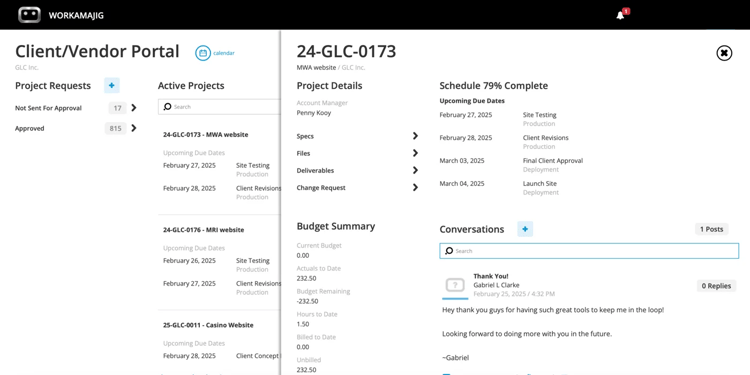A client asks you to take on their project. What happens next?
Do you say, “Sure, when do we start?”, or “Sorry, we’re fully booked now”, or “Thanks for the offer, let me get back to you”?
Unless you’re a very small agency and you only have a couple of projects in your pipeline at any given time, how can you know if taking on that project will add a worthwhile amount to your bottom line? How do you know if you have the resources, and that it won’t take away from other projects? How do you know if this project aligns with your strategic vision?
Enter Project Portfolio Management. After reading this guide, you’ll understand what project portfolio management is, why it’s important, best practices, challenges, and the tools you need to succeed.

Credit: FreePik
What is Project Portfolio Management?
Project portfolio management is a strategic process that involves selecting, prioritizing, and controlling a company’s projects to achieve its goals. Unlike project management, which is about managing projects once they’ve started, project portfolio management is about choosing which projects to take on in the first place, considering resources, risks, and overall value.
Although in the short term it might seem that the best way to handle incoming projects is to take on as many as possible at any given time and simply prioritize the most lucrative ones, the agencies that succeed in the long term are the ones that use PPM to weigh all the essential factors.
What Are The Benefits of Project Portfolio Management?
- Strategic alignment and prioritization: PPM enables you to focus on projects that deliver the highest strategic value and filters out projects that do not align with business goals.
- Improved resource allocation and capacity management: PPM provides a centralized view into all projects and their resource requirements, enabling better distribution of personnel, budget, and other resources.
- Enhanced risk management and visibility: PPM helps you identify interdependent factors that may look like they would work for a particular project, but don’t actually make sense when you consider all your project’s needs together.
- Better financial oversight and ROI optimization: Part of PPM is making financial calculations that help determine which projects have the greatest profit margins. Project portfolio management doesn’t end once you’ve made a decision about which projects to take on; continuously comparing how all projects are faring financially helps you make decisions about which projects to continue and which to terminate before it’s too late.
- Faster decision making: Employing PPM techniques, and particularly, using project portfolio management software, enables faster, more informed decisions.
Overall, adopting a project portfolio management solution significantly reduces project failure rates.
What is The Project Portfolio Management Process For Agencies?
The following project portfolio management process steps enable repeatable and profitable operations.
1. Project intake and discovery
Use project intake forms to organize requests and file them all in a centralized location.
2. Prioritization and selection
To effectively prioritize projects, you need a project portfolio management framework that has a scoring system that ranks resource requirements, overall value, and strategic fit.
3. Portfolio planning and resource allocation
Once you’ve deemed a project worthwhile, you need to determine which should be done first and which must wait due to resource or budget constraints. If you’ll be working on multiple projects at the same time, you’ll need to balance resources, schedules, and budgets.
4. Project execution and monitoring
Track projects as easily as possible. Portfolio project management software is the best solution for monitoring all aspects of projects across a centralized dashboard.
5. Review and optimization
Assess outcomes against KPIs using project portfolio management tools. If something is misaligned, figure out why and act accordingly.
What Makes the Best Project Portfolio Management Software?
Project portfolio management software is a must for fast-paced teams. When choosing software, look out for the following:
- Visual dashboards and analytics
- Custom templates for common agency projects
- Time and expense tracking
- Resource management and utilization reports
- Integration with creative tools (CRM, calendars, asset management)
- Workload balancing and team calendars
- Real-time risk alerts
- Flexible methodologies (Agile, Waterfall, Kanban, or hybrid)
Portfolio Project Management Best Practices
1. Establish a standardized process
Use project portfolio management templates and workflows to automate intake, prioritization, and review.
2. Invest in the right software
Investigate portfolio and project management software tailored specifically to creative teams, as these will give you the best value for money - you won’t have features you hardly need to use. The interface will be intuitive to your team’s needs.
3. Train your team
It’s worth investing in project portfolio management training because if you want it to become a natural part of the project process, you need to train your team across all levels.
4. Stay open to change
Once you’ve got the ball rolling with your project & portfolio management, keep your finger on the pulse. Over time, you’re likely to notice that certain steps are either redundant or need to be replaced with more relevant ones.
Project Portfolio Management FAQs
What are some project portfolio management examples?
1. A marketing agency managing multiple campaigns
PPM approach involves:
- Grouping projects according to their resource requirements, budget constraints, and strategic value
- Using PPM software to track campaign timelines, deliverables, and budgets across the entire portfolio.
- Reallocating designers or copywriters when certain campaigns hit bottlenecks.
- Regularly review ROI per campaign and pause underperforming ones to focus on higher-impact clients.
2. A niche B2B marketing agency prioritizing high-retention clients
PPM approach involves:
- Classifying clients according to retention rates
- Continuously evaluating which clients/projects generate the most value
- Cancel or de-prioritize low-profit-margin projects
How do I get a project portfolio management certification?
The most recognized certification is the Portfolio Management Professional (PfMP) from the Project Management Institute (PMI), which requires documented experience in portfolio management and passing a rigorous exam. Other certifications include Management of Portfolios (MoP) from Axelos and APMG International’s Managing Portfolios certification.
What is the average project portfolio manager salary?
According to Indeed, the average salary for a project portfolio manager is $103 461, with the lowest starting salary at $56 561 and the highest $189 251.
What is a project portfolio management framework?
A project portfolio management framework is what provides the structure, processes, and guidelines for evaluating, selecting, and managing multiple projects within a portfolio. Frameworks can include scoring models, prioritization matrices, roles and responsibilities, and tools for ongoing assessment and improvement.
What industries benefit most from project portfolio management?
Companies that receive a constant flow of project requests, or specifically need to narrow down the projects they take on to the ones that meet certain criteria, benefit most from PPM.
How can project portfolio management software improve agency profitability?
PPM helps agencies identify areas for improvement by providing a clear overview of project dynamics, costs, resources, etc, and helps spot bottlenecks and eliminate wasted time or money.
How can Workamajig help you with your project portfolio management?
Workamajig stands out as the only project management software designed specifically for creative and marketing agencies. As such, we offer unmatched project portfolio management assistance with our:
- All-in-one dashboard to track every project in your portfolio, providing real-time visibility and alerts to resource conflicts, overdue milestones, and potential budget overruns.
- Custom templates and automation to streamline project intake and planning, so you launch every campaign faster and more accurately with repeatable processes.
- Integrated task, time, and expense management, empowering teams to balance creativity and profitability by seeing the full resource picture at a glance.
- Interactive visualizations and Gantt charts for intuitive scheduling, allowing teams to customize project phases and spot bottlenecks quickly.
- Deep CRM integration for seamless client handoff from sales to project delivery, ensuring nothing gets lost and every opportunity is maximized.
With Workamajig, creative and marketing agencies achieve first-class project and portfolio management and delight clients every time. Start today!

Originally published October 27, 2025.

